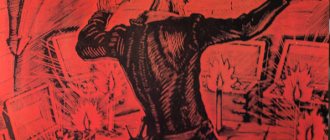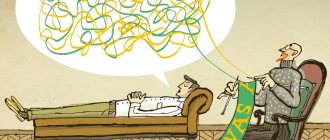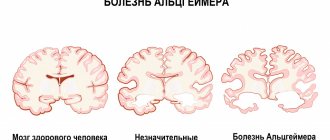Let's take a look back at your childhood and try to remember how you interacted with your peers while hanging out together. Surely you had a more or less formed team, where you made friends, fell in love, communicated, built a hut, stole candy from the store, played “Duck Hunters,” etc. But if we remember one detail, we think it will be true for each of you, dear readers, namely: all these processes were monitored by a certain person who resolved internal issues and directed the tactics of action in a certain way. This man was the leader, or rather the informal leader.
How did he stand out? Most likely, this was a person about your age, perhaps a little older, he/she had a strong character, he/she was characterized by initiative, ideological spirit, the last word in some disputes (like how many packs of seeds to buy or who will go for the ball hit out of bounds) remained behind him/her, etc. Thus, all other team members felt a certain authority of the leader.
But why do we call it informal? And if there is an informal leader, is there a formal one? How can we generally understand who is the leader in a team, and why do they appear as a matter of course in any united community? How to become an informal leader in your team, and is it necessary to become one at all? We invite you to think about this and other questions together.
Leadership concept
Leadership is a system of functioning of a social group in which there is a specific leader in the group.
This person organizes others, makes key decisions, acts as an authority, and is able to lead.
He takes responsibility for making decisions that are important to all members of the group. At the same time, other participants recognize his authority and listen to his opinion.
The concept of leadership is actively used in psychology, management, sociology, political science and other disciplines. For this reason, there are many approaches to studying this phenomenon.
Experts have also developed several different classifications of the types of this phenomenon.
Signs
The presence of a leadership system in a group is evidenced by the recognition by the majority of its members of the authority of a person.
This person makes decisions, organizes activities, and bears responsibility. The main characteristics of a leader:
- Foresight . He knows how to predict the development of events and convince others of the correctness of the chosen strategy.
- Thoughtfulness . He always approaches solving any problems calmly and judiciously, without fuss or hasty conclusions.
- Ability to understand people. He understands the essence of man, his inherent weaknesses and strengths. This helps to objectively assess everyone’s abilities and use these abilities as competently as possible in the common cause.
- Activity . This position is very difficult emotionally, since responsibility is always a source of stress. The leader must be physically and psychologically resilient, only in this case the burden placed on him will be feasible.
- Determination .
Failures do not become a reason to abandon your ideas, but are perceived as useful lessons on the way to achieving your goals. Facing difficulties does not confuse you, but only stimulates you to look for ways to overcome them. - Subsequence . People feel comfortable only when the reality around them is predictable and stable. It is the ability to build a correspondence between the chosen strategies, the techniques used and the achievement of expected results that is the key to the trust of group members. The inconsistency and variability of the leader always causes the destruction of any community.
- Justice . A team or social group will trust someone who treats everyone around him equally, without exception. The presence of favorites and close associates always leads to a deterioration in the psychological climate in any group.
- Cool mind. Decisions often have to be made on the spur of the moment to save the overall idea, but they can infringe on the rights of individuals. Often you need to sacrifice less in order not to lose more. Excessive emotionality and softness do not benefit a leader, who must always be guided by rational considerations.
Read about the causes of conflicts in organizations and ways to prevent them here.
How to develop leadership qualities
As a rule, it is he himself who prevents leadership from emerging in a person. Or rather, its internal barriers. Barriers can be psychological, for example, internal deep-seated beliefs. In the case of a teacher, he is 100% convinced that he cannot earn money by working as a teacher, and he does not even realize that he is limiting himself .
If you have similar problems, read the article: “Development of a leader’s personality - an example of solving problems with money,” there are examples of how such barriers work and how they can be removed.
Or the barrier may be in the form of psychological complexes, for example, excessive shyness; a person cannot speak in public, and without this skill one cannot become a leader .
Or a person experiences irrational fears, that is, in making decisions he is stopped by an internal monologue in his head, what if something goes wrong, what if something happens. A person who is afraid to make a decision also cannot become a leader.
In most cases, in order to overcome some kind of barrier, it is suggested to break yourself, to break yourself over the knee. For example, still go on stage and speak in public, even if the person is shaking with fear.
But why not act smarter, why doesn’t anyone want to choose a different development strategy: for example, remove the barrier. Psychotechnology to get rid of these psycho-complexes once and for all is in this book.
It’s a mistake to force yourself to do something, forcing yourself for a long time will not work, barriers need to be removed, and not waste energy on overcoming them. Ideally, there should still be a deep, essential motivation. For leadership there must be an understanding of one's mission in life, an understanding of its meaning . Examples for discovering the meaning and purpose of life are in this article.
It is critically important to discover exactly your goals and meanings, which emotionally resonate in your body, cause a surge of strength, and emotional uplift . Do not confuse this with what the “matrix” imposes on us, successful success, money, expensive clothes, and under the Soviet Union this was the construction of communism.
Functions
The main functions that a leader performs in a social group:
- predict the development of events and take measures to develop an action strategy,
- to take responsibility,
- set tasks for group members,
- distribute responsibilities according to the abilities of each participant,
- provide moral and practical support in solving problems,
- motivate to achieve high results,
- strives to achieve common, rather than personal interests,
- in case of failure, bear responsibility for the mistakes made.
Formal and informal
All experts tend to divide leaders into two types: formal and informal.
A formal (nominal) person who occupies a certain social status or position, according to which he is endowed with certain powers of authority.
These are managers at various levels : heads of departments, managers, directors, etc. Such people bear personal responsibility for mistakes made by their team. Their task is to organize work and achieve set goals.
Informal (real), a person who is respected and valued by all members of the group not because of his status or position, but because of his inherent moral qualities. Such a person has intelligence, charisma, charm.
He is always a strong and positive person who inspires confidence and calm in others. He is able to influence group members and direct their activities.
What is the difference?
A formal leader always acts within the framework of the powers with which he has been given . If his professional qualities correspond to his position and are complemented by high moral characteristics, then such a leader can have real power over the team.
If the level of his professionalism does not inspire confidence in his subordinates or his personal qualities interfere with the establishment of a positive psychological climate in the team, then the function of the leader remains only nominal.
Members of the group will obey such a person only within the framework of the duties they perform , but there will be no talk of any recognition of authority here.
An informal leader has the ability to influence other group members due to his business and personal qualities.
In the workforce, the real representatives of power, as a rule, are experienced specialists with a high level of knowledge of their duties.
In addition to professionalism, these people demonstrate self-confidence, reliability, and responsibility. They are also always charming, sociable, and fair. Such an informal authority has much more power than a real leader.
This is explained by the fact that in an organization with a full-fledged acting leader who enjoys the respect of his subordinates, an informal leader cannot, in principle, appear.
Formal and informal leadership, what does it mean and what is the difference:
List of used literature
1.Ushakov K.M. Organization development: in search of adequate theories. - M.: September, 2004. - 192 p.
2. Frolov S.S. Sociology. Textbook. For higher educational institutions. M.: Nauka, 1994 - 256 s.
3. Frolov S. S. Sociology of organizations: Textbook. M.: Gardariki, 2001. 304 p.
4. Anton Milekhin Is it worth firing a “nuisance” informal leader? https://hh.ru/contents/publication.do?publicationRubrikId=52&publicationId=704
5.Platonov Yu.P. Structure and conditions of leadership www.elitarium.ru
Similar works
Authority, leadership and power in management.
Problems of leadership and authority of the manager in the team of a foreign trade organization
Authority, leadership and power in management.
Analysis of authority, leadership and power in management in order to improve the efficiency of the management system in the organization
Authority, leadership and power in the management of an organization 2
THE RELATIONSHIP BETWEEN COHESION AND TRUST IN SMALL GROUPS AND INFORMAL SUBGROUPS
Social and psychological characteristics of leaders and managers
Leaders and types of leaders. Leader's image
Merger of daughter and mother and its consequences for the marriage and family relationships of the daughter
Features of a figurehead leader
Such a personality is characterized by the following characteristics:
- Appears and disappears depending on circumstances . This happens during various transformations, crises, etc. For example, a change in formal leadership can lead to either the emergence of a real leadership role or the abolition of the need for it. The leaders themselves may also change depending on the prevailing circumstances.
- Can interact effectively with other leaders. Often in a social group there are several people who occupy key positions.
At the same time, their spheres of influence do not overlap in any way, and joint efforts are directed towards achieving a common goal. It is this kind of effective interaction that often produces truly significant results. - Dedicated to the common cause. Coordinates the actions of team members to achieve assigned goals. Interested in the integrity of the team and the effectiveness of its activities. He uses his influence and authority not for the purpose of achieving personal interests, but solely for the purpose of solving common problems.
- Internally he loves to manipulate people. Whatever good intentions guide the actions of the informal leader, he does not choose his position by chance. This is always a person who likes to have power over other people and influence the course of events. For this reason, real leaders often dream deep down of becoming formal leaders, since this will give them official powers.
conclusions
How to make informal relationships work for the benefit of business?
- Understand and shape the company culture. Hire people who share your values. Get rid of those who act against them.
- Regularly work on team building. Create and develop formats in which people can establish informal relationships.
- Respond to disruptive deviations. Remember that you are a manager and therefore the guardian of your company's culture.
And most importantly: get to know your people! Competently weave informal relationships into working relationships. This will give you a complete picture, which in turn will allow you to make more informed decisions.
The role of a real leader
A real leader can perform several different roles:
- ",Conductor", .
Fulfills the task assigned to him by the leadership, which does not strive for excessive democracy. Builds relationships in the team in accordance with the course set by his superiors. It is important for him to realize his own importance due to the need experienced by management for his help. He is distinguished by his diligence and friendliness, thanks to which he slowly but surely moves up the career ladder. - ",Shirt-guy", . A sociable and charming person who easily gains the trust of individual members of the team. With the help of a positive attitude, which he infects other people with, he sets up his colleagues to perform initially tedious and routine tasks with enthusiasm. Enjoys the feeling of being on the same level with leaders.
- ",Eminence grise", . A secretive and slightly boring person who prefers to act quietly and efficiently. He is happy to be formally on the sidelines, fully aware of the real importance of his position. Such secret power gives him pleasure. Pays attention to little things and nuances, thanks to which he always finds an approach to any person. An excellent manipulator and first-class strategist.
- ",Rebel", . He chooses his position as an unspoken leader only because of the desire to influence the masses in order to organize a rebellion. The purpose of his activity is to set conditions, fight for the rights of the disadvantaged and other aggressive actions that are in no way directly related to the real goals of the group. He fights for the sake of fighting itself, and the final goal is secondary.










